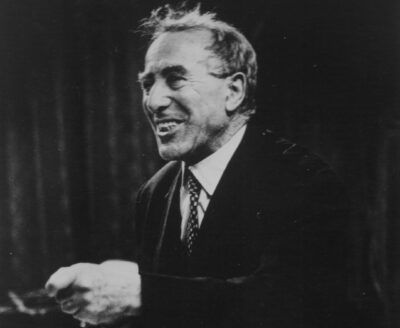A.N. Stencl: Berlin’s Vagabond Yiddish Poet

During the fifteen years Avrom Nokhem Stencl (1897–1983) lived in Berlin, between the world wars, he published an astounding nineteen books in Yiddish, mostly of poetry.
He became well-connected in the vibrant Yiddish literary scene at that time, but his poverty and adventurous nature led him all over the metropolis, to soup kitchens, homeless shelters, prayer rooms, graveyards, squats, a student union, an art school, even Moabit prison (he lacked residency papers) and outward to the countryside for farm work. Thus began a long adulthood as an insider-outsider.
After leaving Berlin for London in 1936, Stencl was largely dismissed or ignored by the Yiddish literary establishment, although he was a central figure in London’s Yiddish cultural scene for four decades.
A rediscovered legacy
Since 2023, I have been part of a growing wave of interest in the poet and his legacy. Here in Berlin, I have participated in a weekly reading group, a Yiddish.Berlin exhibition, a Stencl zine, and presentations of Stencl translations at the Nu? open mic series. Colleagues here and in the UK are actively translating his work into English, German, Polish, and Hebrew.
In England, the writer and artist Rachel Lichtenstein has spearheaded a variety of Stencl-related initiatives, in which I have also participated: an international digital archive, an online mapping project, and a week-long residency at the Manchester Poetry Library where a group of us discussed Stencl’s literary journal, Loshn un Lebn, in the language in which it was published. Lichtenstein is currently writing a book of nonfiction that will tell the story of the poet’s life and contemporary afterlife.
Translating an untold Berlin story
Stencl’s memoirs of his formative years in Weimar Berlin, which he serialized in the pages of Loshn un Lebn in the late 1960s and early 1970s, make gripping reading. They are gritty and rambunctious but also contemplative and lyrical (he was, after all, a poet).
Apart from these texts’ literary merits and the joy they are to read, they also constitute a unique historical document. In my wide reading on Berlin’s Yiddish history, I have yet to come across any other book-length work of nonfiction that portrays the heady heyday of Yiddish literature in Berlin.
I am currently translating the first volume of these memoirs, titled Gerangl (Hustle), thanks to a grant from the Berlin Senate Department of Culture and Social Cohesion and a Literary Translation Fellowship from the Yiddish Book Center.
Read sample translation from “Gerangl”
You can read an excerpt of my ongoing memoir translation, preceded by an introductory essay here on In Geveb.